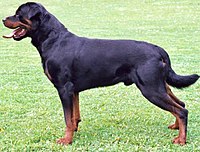
Photo from wikipedia
Importance Hidradenitis suppurativa (HS) is a disease of the terminal hair follicle in apocrine gland–enriched skin areas, where immunobiology dysregulation of mesenchymal stem cells (MSCs) may have a key role.… Click to show full abstract
Importance Hidradenitis suppurativa (HS) is a disease of the terminal hair follicle in apocrine gland–enriched skin areas, where immunobiology dysregulation of mesenchymal stem cells (MSCs) may have a key role. Objective To investigate the MSC profile in patients with HS and in healthy controls. Design, Setting, and Participants In this prospective case-control study, patients with HS were recruited from the Dermatological Clinic at the Department of Clinical and Molecular Sciences, Università Politecnica delle Marche, Ancona, Italy. Biopsy specimens were analyzed at the Histology Section of the Department of Clinical and Molecular Sciences. Participants included 11 patients with HS and 9 healthy controls, who were recruited into the study between January 20, 2015, and September 20, 2016, and underwent punch biopsy from axillary skin. None of the participants had received any antibiotics (systemic or topical therapy) within almost 12 weeks before the study. Main Outcomes and Measures The immunophenotypic profile of MSCs was characterized following the minimal criteria established by the International Society for Cellular Therapy for the identification of MSCs. Levels of 12 cytokines belonging to helper T-cell subtypes 1, 2, and 17 pathways were examined on the secretome of isolated cells by enzyme-linked immunoabsorbent assay. Results Skin MSCs were characterized in 11 patients with HS (8 women and 3 men; mean [SD] age, 35.8 [7.9] years) and 9 healthy controls (7 women and 2 men; mean [SD] age, 36.7 [6.9] years). The healthy controls were matched with patients with HS for body mass index. Mesenchymal stem cells isolated from patients with HS (HS-MSCs) and from healthy controls (C-MSCs) met the International Society for Cellular Therapy minimal criteria. Compared with C-MSCs, cytokine analyses of HS-MSCs revealed statistically significant overexpression of interleukin (IL) 6 (median [interquartile range {IQR}], 8765.00 [7659.00-9123.00] vs 2849.00 [2609.00-3001.00] pg/mL; P = .008), IL-10 (median [IQR], 29.46 [26.35-35.79] vs 21.36 [19.89-23.33] pg/mL; P = .004), IL-12 (median [IQR], 15.25 [13.27-16.25] vs 11.89 [10.73-12.33] pg/mL; P = .03), IL-17A (median [IQR], 15.24 [13.23-17.24] vs 11.24 [10.28-11.95] pg/mL; P = .008), tumor necrosis factor (median [IQR], 42.54 [42.20-43.94] vs 32.55 [31.78-33.28] pg/mL; P = .004), transforming growth factor &bgr;1 (median [IQR], 1728.00 [1535.00-1979.00] vs 500.80 [465.00-634.50] pg/mL; P = .004), and interferon &ggr; (median [IQR], 11.49 [10.71-12.35] vs 9.45 [9.29-10.01] pg/mL; P = .005). Conclusions and Relevance Mesenchymal stem cells isolated from the skin of patients with HS seem to be activated toward an inflammatory status. The imbalance between proinflammatory and anti-inflammatory activities of MSCs favors the hypothesis of their pathogenic involvement in HS.
Journal Title: JAMA Dermatology
Year Published: 2018
Link to full text (if available)
Share on Social Media: Sign Up to like & get
recommendations!